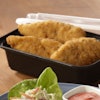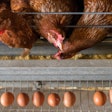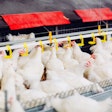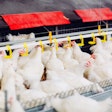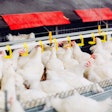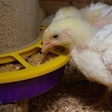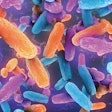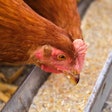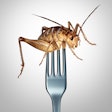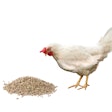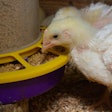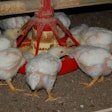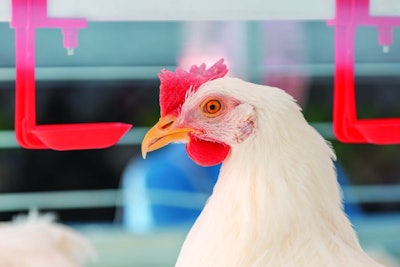
Many minerals and other substances are naturally present in water, usually in amounts that do not interfere with poultry performance. However, when the levels of certain chemicals are out of balance, they can either directly or indirectly impact productivity.
Consider the following to evaluate and identify possible water quality issues.
Keep a close eye on the primary water source
Water composition varies with region, soil type and other natural ground characteristics.
In addition, water sources can be influenced by, amongst other factors, droughts, floods, septic systems, agriculture and industry within an area and other factors.
Test regularly and appropriately
Due to the large number of possible chemicals in water, it is critical to understand any specific problem within the facility. In order to monitor water quality:
- Establish a baseline under normal conditions.
- Monitor on a regular basis to detect any fluctuations within water quality.
- Conduct additional water tests during periods of heavy rain or drought to ensure that water quality remains adequate.
The results of water analysis will only be reliable if samples are taken correctly.
When collecting samples, sterilize the outlet prior to collection, allow water to run for several minutes to obtain a representative fresh sample and place the sample in a sterilized container. Submit samples promptly to a trusted laboratory approved by the integrator.
Consult with the integrator’s field technicians regarding the appropriate substances to evaluate and to assist in interpreting the water analysis results. The results must be interpreted appropriately to determine the proper course of action.
Consider the direct impact of chemicals
Some substances will directly impact broiler health and performance. Be sure to test for the following:
- Confirm water is free of toxic compounds, such as lead, selenium and arsenic.
- Check for indicators of groundwater or sewer contamination, such as dissolved oxygen, high levels of phosphate and nitrates/nitrites. Of particular concern are nitrates/nitrites, which result from the biological decay of animal or plant matter, chemical fertilizers or animal waste. Although nitrate itself is not toxic, after consumption, it is converted to the more toxic form of nitrite. Nitrite reduces the blood’s oxygen carrying, which can result in poor growth, decreased feed consumption and poor coordination.
- High levels of chloride, sulfate, sodium and other chemicals can have a diuretic effect, which increases water consumption, litter moisture and adversely affects air quality in the poultry house.
- The measurement of total dissolved solids (TDS), or salinity, indicates levels of inorganic ions (calcium, magnesium, potassium, sodium, bicarbonates, chlorides and sulfates) dissolved in water. High TDS can result in watery feces, increased mortality and decreased growth and production.
- Elevated levels of iron and manganese change the taste of water and can cause gastrointestinal tract disorders.
- Too much copper changes the water’s taste and odor and might cause liver damage.
- If the water supply has high levels of sodium and chloride, the birds could easily consume too much total salt, which could lead to flushing, wet litter, increased ammonia levels, poor paw quality and other problems.
- Many substances, by themselves, can be tolerated at high levels. However, in combination, much lower levels can impact poultry performance. Examples include sodium in combination with sulfate and chloride or magnesium in combination with sulfates.

Consider chemicals’ indirect impact
It is equally important to test for chemicals that can indirectly reduce broiler performance. For example:
- The suspension of materials such as silt, clay, algae or organic materials in water can result in unpalatable water, indicate surface contamination and can interfere with the proper operation of watering equipment.
- Water that is reddish-brown might contain excess iron, which will stain waterers, produce bad odor and taste, form particulates that cause equipment problems and may encourage growth of iron bacteria.
- Sulphur, usually in the form hydrogen sulphide, causes a rotten-egg smell and can cause a black residue on the filter canister or housing.
- Excessive levels of manganese (Mn) can result in an off flavor/flavor problem and can form solid particulates and black sediment in water.
- The combination of calcium, sodium and magnesium determines the hardness of water. Hard water can reduce the effectiveness of soaps and disinfectants, interfere with the administration of vaccines and medications and over time cause scale buildup in water lines, reducing pipe volume and equipment function.
Corrective steps
Once water quality issues have been identified, consider the following corrective steps:
- Evaluate installing a filtration system.
- If you have a filtration system, change filters regularly and ensure that filters are appropriate for the identified contaminants.
- Perform a high-pressure flush on water lines between each flock and after using water supplements.
- Before implementing a new program, consult with field service technicians to ensure contaminants in your water will not react negatively and cause the water system to become clogged.
- If hardness is a concern, use softeners cautiously. Softeners replace calcium and magnesium with sodium. In the long run, this may simply substitute one ion for another, potentially increasing sodium to unacceptable levels.
- When a problem is severe, consider alternative sources of water. If the contamination source cannot be controlled, a new, deeper and better constructed well may be the only resolution.
How to control bacteria growth in poultry water systems

